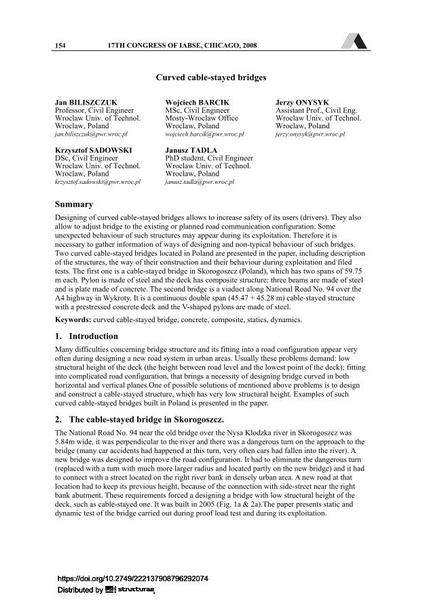Curved cable-stayed bridges

|
|
|||||||||||
Bibliografische Angaben
| Autor(en): |
Janusz Tadla
Jan Biliszczuk Wojciech Barcik Jerzy Onysyk Krzysztof Sadowski |
||||
|---|---|---|---|---|---|
| Medium: | Tagungsbeitrag | ||||
| Sprache(n): | Englisch | ||||
| Tagung: | 17th IABSE Congress: Creating and Renewing Urban Structures – Tall Buildings, Bridges and Infrastructure, Chicago, USA, 17-19 September 2008 | ||||
| Veröffentlicht in: | IABSE Congress Chicago 2008 | ||||
|
|||||
| Seite(n): | 154-155 | ||||
| Anzahl der Seiten (im PDF): | 8 | ||||
| Jahr: | 2008 | ||||
| DOI: | 10.2749/222137908796292074 | ||||
| Abstrakt: |
Designing of curved cable-stayed bridges allows to increase safety of its users (drivers). They also allow to adjust bridge to the existing or planned road communication configuration. Some unexpected behaviour of such structures may appear during its exploitation. Therefore it is necessary to gather information of ways of designing and non-typical behaviour of such bridges. Two curved cable-stayed bridges located in Poland are presented in the paper, including description of the structures, the way of their construction and their behaviour during exploitation and filed tests. The first one is a cable-stayed bridge in Skorogoszcz (Poland), which has two spans of 59.75 m each. Pylon is made of steel and the deck has composite structure: three beams are made of steel and plate is made of concrete. The second bridge is a viaduct along National Road No. 94 over the A4 highway in Wykroty. It is a continuous double span (45.47 + 45.28 m) cable-stayed structure with a prestressed concrete deck and the V-shaped pylons are made of steel. |
||||
| Stichwörter: |
Beton Verbund
|
||||
